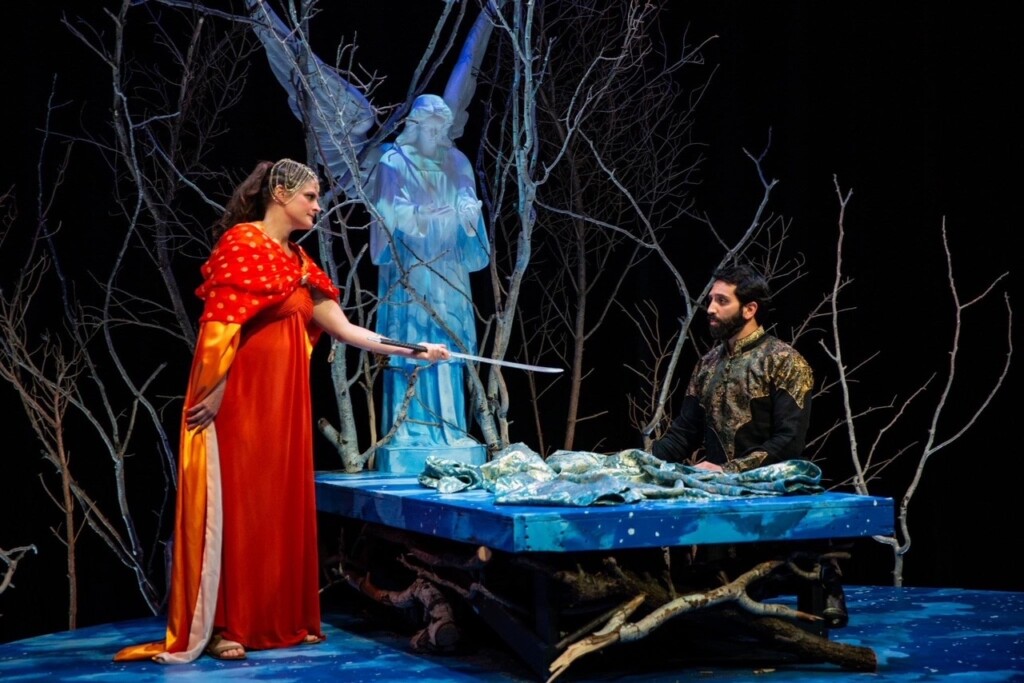Watching Sleeping Beauty’s Dream, by Javen Tanner, in a recent production by The Sting & Honey Company, one can appreciate the cosmopolitan melange of myths that supersedes the traditional Disney-like narrative portrayal. Tanner’s script shows that the relationships connecting the romantic lead characters extend beyond physical attraction into loyalty, commitment, friendship and dignity.
The results are satisfying, especially in the elegant, moving tone of the play’s closing moments. Tanner’s version, which was previously produced five years ago and is a part of a company trilogy that includes Snow White and Cinderella, emerged from ideas about what the princess would have been dreaming about during her long sleep. Drawing upon Norse and Germanic mythology, Tanner imagines Princess Aurora (Rain Flower Tanner) dreaming about being Brunhilde, the Valkyrie daughter of Wotan (Odin). The mythological parallel works, as Odin (Bijan Hosseini), god of war, cursed Brunhilde by putting her to sleep because she disobeyed him. Tanner’s version adds in the fact that Odin cannot abide the fact that Brunhilde does not love him. During Aurora’s many years of sleep, the conflicts and tensions in her dream comprise a good part of the play’s action.
Tanner incorporates other mythological foundations, such as casting the three good witches from the Greek goddesses of night, time and youth, respectively— Nyx (Kathryn Atwood), Ananke (Susan Maurer Berry) and Hebe (Liberty Miller). The fourth witch, the evil one, is Sycorax (Deena Marie Manzanares), which comes from Shakespeare’s The Tempest. Tanner also throws in Robin (Will Kemble), a clown, for comic relief. Overall, the cast delivers wonderful performances in a production that is suited to audiences of all ages.
The contours of Tanner’s version remind of the eclectic approach that Hayao Miyazaki took in his work, most notably Ponyo, which is his version of The Little Mermaid, the classic tale by Hans Christian Andersen, also immortalized in Disney animation. In Miyazaki’s rendering, the story’s Japanese roots are joined by mythic and folkloric elements from around the world. Coincidentally, Ponyo’s birth name is Brunhilde. She is transformed from a goldfish into a little girl by her mother Gran Mamare, the ocean goddess of mercy. This happens after the boy with whom Ponyo has become friends promises the goddess that he will respect Ponyo and care and watch out for her.
The honor of oath and obligation figures significantly in Tanner’s version of the Sleeping Beauty story. Tithonos is Aurora’s suitor but he refuses the good witches’ offer to put him to sleep, which otherwise would have preserved his youthful looks. Meanwhile, when Aurora is asleep, in her dreams, Siegfried is her suitor. But, when she is awakened, it is Siegfried’s counterpart in reality, Kephalos, who becomes Aurora’s suitor.
Tithonos is now very old and lame, and wonders if Aurora, who is exactly the same as when she was put to sleep a century before, will remember him. Tithonos has sacrificed heroically, waiting patiently for the day when Aurora and the townspeople would awake again. In a brief moment, Aurora sees the aged Tithonos as someone who is remotely familiar and acknowledges him as a friend. The town is jubilant that Aurora and Kephalos are joined as a couple. But, Tithonos is left alone on stage at the end and Nyx acknowledges the enormity of his grace and sacrifice. It is a truly touching moment.
The production design excels in its visual appeal, especially at the Regent Street Black Box Theatre at the Eccles Theatre in downtown Salt Lake City (the run ended July 30). The set was a circular platform raised slightly above the stage with lighting underneath and was adorned with branches and brambles that crept up toward the top, where the bed was located. At the center in the back of the set is a statue of an angel. There also was Brunhilde’s gold helmet. The image is like a secular altar, where homage is paid to the spirits and the ethereal natural surroundings that have been embodied in the myths and folklores representing virtually every human culture of storytelling.




2 thoughts on “The Sting & Honey Company offers an elegant cosmopolitan palette of myth and folklore in Sleeping Beauty’s Dream”